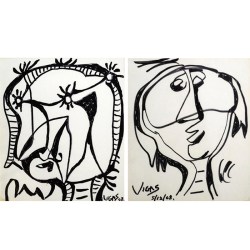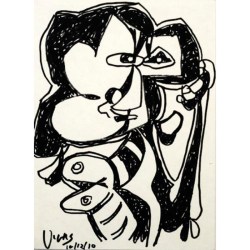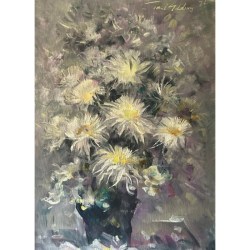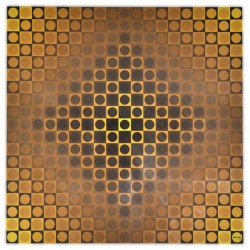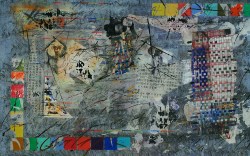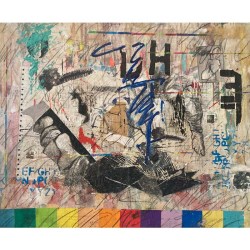Bio
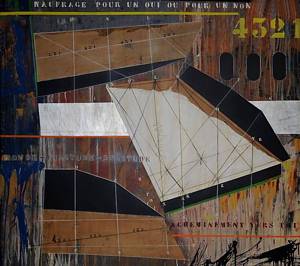 Painter and mixed media artist. He studied at the Trujillo's Athenaeum Fine Art Workshop (Taller de Artes Plásticas del Ateneo de Trujillo) (1960-1963), and works as a professor at the Valera Fine Art School (Escuela de Artes Plásticas de Valera) (1964-1967). In 1968 he moves to Paris, where he receives a scholarship from the French government (1970) and continues to study art criticism with Frank Popper, becoming his assistant at the creativity workshop (1971) at the Vincennes Experimental University (Centre universitaire expérimental de Vincennes) (France), where he was designated associate assistant (1974) in order to teach contemporary art courses, role which he currently exercises. From the beginning, his body of work is identified with the kinetic art style, incorporating other elements like audience participation, in order to not only transform the artwork itself but also to make it an essential part of the creative process - process which the artist refers to as "perceptivism" - such as in his tactile 'Psychomagnetiques', presented in his first individual exhibit (MBA, 1976). In 1978 he obtains an investigative scholarship from the John Simon Guggenheim Foundation, which he maintains for only 3 months in order to avoid interrupting his Paris professorship. Parting from the aforementioned investigation surges the "Polysensorial Alphabet" ("Alfabeto Polisensorial"), which principle, as expressed by the artist himself is "the uninhibited creative capacity during the time in which one learns to read (as it's common to notice), and to place on equal ground those children who come from different sociocultural resources, and to eliminate the teacher's 'ever-right' power" (1979). In the year of 1980 he exhibits at the GAN the sample "Polisensorial Alphabet and Other Writing Propositions" ("Alfabeto Polisensorial y Otras Proposiciones sobre la Escritura "). Between 1978 and 1980, Comenárez develops a work inspired by urban graffiti which he names "Psicograffitierra", steel surfaces covered by metallic dust, in order for the spectator to intervene in the artistic process by drawing onto its surface and modifying it to taste. From 1981, year in which he exhibits "Manipulable Structures" ("Estructuras Manipulables"), at the Reattu Museum in Arles (France), 6 years will go by without individual exhibit activities, until 1987 when he exhibits his "Love Letters to Japan" ("Cartas de Amor al Japón") at the K Gallery in Tokyo. In 1988 he crafts a sculpture of great dimensions for the Olympics at Seoul (South Korea).
Painter and mixed media artist. He studied at the Trujillo's Athenaeum Fine Art Workshop (Taller de Artes Plásticas del Ateneo de Trujillo) (1960-1963), and works as a professor at the Valera Fine Art School (Escuela de Artes Plásticas de Valera) (1964-1967). In 1968 he moves to Paris, where he receives a scholarship from the French government (1970) and continues to study art criticism with Frank Popper, becoming his assistant at the creativity workshop (1971) at the Vincennes Experimental University (Centre universitaire expérimental de Vincennes) (France), where he was designated associate assistant (1974) in order to teach contemporary art courses, role which he currently exercises. From the beginning, his body of work is identified with the kinetic art style, incorporating other elements like audience participation, in order to not only transform the artwork itself but also to make it an essential part of the creative process - process which the artist refers to as "perceptivism" - such as in his tactile 'Psychomagnetiques', presented in his first individual exhibit (MBA, 1976). In 1978 he obtains an investigative scholarship from the John Simon Guggenheim Foundation, which he maintains for only 3 months in order to avoid interrupting his Paris professorship. Parting from the aforementioned investigation surges the "Polysensorial Alphabet" ("Alfabeto Polisensorial"), which principle, as expressed by the artist himself is "the uninhibited creative capacity during the time in which one learns to read (as it's common to notice), and to place on equal ground those children who come from different sociocultural resources, and to eliminate the teacher's 'ever-right' power" (1979). In the year of 1980 he exhibits at the GAN the sample "Polisensorial Alphabet and Other Writing Propositions" ("Alfabeto Polisensorial y Otras Proposiciones sobre la Escritura "). Between 1978 and 1980, Comenárez develops a work inspired by urban graffiti which he names "Psicograffitierra", steel surfaces covered by metallic dust, in order for the spectator to intervene in the artistic process by drawing onto its surface and modifying it to taste. From 1981, year in which he exhibits "Manipulable Structures" ("Estructuras Manipulables"), at the Reattu Museum in Arles (France), 6 years will go by without individual exhibit activities, until 1987 when he exhibits his "Love Letters to Japan" ("Cartas de Amor al Japón") at the K Gallery in Tokyo. In 1988 he crafts a sculpture of great dimensions for the Olympics at Seoul (South Korea).
He remains distant from the national plastic arts for almost a decade, until he returns to Venezuela in 1989 with the "Scores" ("Partituras") proposal, exhibited at the RG Hall (Sala RG), a group of large-scale artworks and installations, where the artist showcases a new way of communicating with the spectator throughout varied symbolism reminiscent of the Morse code, as well as the introduction of phrases and concepts. New elements within his work include the appearance of color, as well as the fact that his creations cease to be ephemeral, in order to address permanency. During that year, the organizers at the II Guayana Biennial (II Bienal de Guayana) dedicate the event to him as a form of homage. At the same time, he crafts a sculpture for the gardens at the Antioquia University (Universidad de Antioquia) (Colombia), and he participates at a collective exhibit in tribute to the bicentennial of the French Revolution, which takes place at the Saint-Louis Chapel of Salpétrière in Paris. Carlos Cruz-Diez, Narciso Debourg, Víctor Lucena, Alejandro Otero, Rolando Peña and Jesús Soto accompany him at the exhibition. In 1990 he finds himself in Caracas, in order to teach at the workshop titled "Vacuum: A Pictorial Resource that Awakens Imagination" ("El Vacío: Un Recurso Pictórico que Despierta la Imaginación"), at the Federico Brandt Institute, and to present the exhibit "The Wings of Desire" ("Las Alas del Deseo"), at the Uno Gallery: mixed-technique paintings which, according to Enrique Viloria, are "a proposal which we can characterize as a playful synthesis" (1990). On that same year, he participates at the "Ethnosonic Thresholds" ("Umbrales Etnosónicos") exhibit, polysensorial experience which counts with the participation of musician Ángel Rada and Victor Lucena at the 'Galería Astrid Paredes de Caracas'. In 1991 he's displayed at the GAN, alongisde the Soto Museum and sponsored by Caroní Aluminium (Aluminio del Caroní), project which is defined by the artist as a confrontation between nature and technology; "Asdrúbal Colmenárez. Prelude 7, fugue 7" ("Asdrúbal Colmenárez. Preludio 7, fuga siete"), where the artist stablished a dialogue between the plastic arts' language and the language of music, with which he concludes his Scores work, in order to give way to new quests. Back in Caracas, in 1993, he presents "Mare Nostrum: Paintings & Sculptures" ("Mare Nostrum: Pinturas y Esculturas), at the MACCSI. According to Eduardo Planchart Licea, the series "possesses the spirit of his first creations, made in Trujillo, under the guidance of Chilean artist Dámaso Ogaz" (1993).
After 3 years of absence from the Venezuelan plastic arts' scene, in 1996 MAO organizes "Space Species" ("Especies de Espacio"), a series of installations with a participative and playful character, reminiscent of his Psychomagnetiques due to its level of audience interactivity. On that same year, Ars Forum Gallery (Caracas) makes a retrospective of his body of work, ranging from 1968 to 1994. In 1998 he presents "Transposition" ("Transposición") at the MACCSI, in which, once again, audience interaction becomes a part of the artwork. María Luz Cárdenas writes on the sample catalogue: "The validity and main attraction of this exhibit is the playful interaction of multiple elective affinities presented to the audience, in order to convert art history in an artwork that copies itself, changes itself, and makes every image and fragment of that history a bundle of senses, a handful of semantic seeds which sprout in the audience's consciousness" (1988). Regarding his most participative artworks, Juan Calzadilla writes the following: "Throughout his tactile and magnetic [works], he insists in the element of audience participation as the motor running the artwork. Making use of magnetic strips, he leaves to the audience the possibility of crafting every possible combination, in order to create shapes at will, so that the creator becomes a creator of new plastic entities from the variating and manipulable elements" (1977, pp. 218). GAN owns a set of some of his most representative artworks: Psychomagnetique no. 151 in black, and Psychomagnetique no. 159 (magnetic strips, plastic and metal on wood; 1975), Polysensorial Alphabet (Alfabeto Polisensorial) (metal assembly, plastic, painting and acrylic; 1979) and Structure I (Estructura I) (sheets of steel and wax sculpture; 1992).


